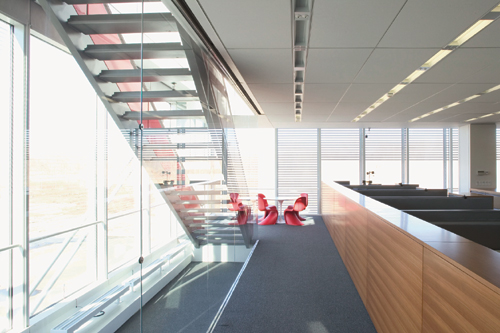The Case For Commissioning
Boldly, the client opted to create an unusual procurement specification. Eligible manufacturers were invited (and given a stipend) to develop, test, and prove that their products would perform as designed. Eventually Lutron and MechoShade won the opportunity to create an integrated, dynamic lighting and shading package which, because of the extensive testing and research prior to design, fell within the typical lighting budget for a Class-A building.
The Times also opted to deliver air on its own floors through a raised-floor system rather than through conventional ceiling diffusers. Because there are few examples of this system in U.S. buildings (Thurm claims this is the first large installation of under-floor air in Manhattan), the client hired Flack + Kurtz, which has done pioneering work in this area, to design this atypical air-distribution system. In a perfect example of commissioning-as-you-go, the client conducted an "under-floor summit" with HVAC professionals to develop a protocol for constructing this type of system. Mock-ups were tested and double-checked by an expert in fluid dynamics. This enabled the engineers to continue to improve the design prior to installation. As the kinks were worked out of the design, the engineers were reasonably certain that once the complex systems were installed in the new building, the need for time-consuming and expensive commissioning would be significantly reduced.
|
As the federal and the New York Times buildings illustrate, commissioning has evolved from a perfunctory make-sure-everything-works procedure to an integral part of the design process. Performance-based specifications require systems be optimized after they're verified. To keep up with the new generation of building systems, better controls are constantly being developed to measure and record every parameter to ensure not a Btu is wasted.
Justifying the commissioning process in a construction budget is not difficult, at least in terms of potential savings. One way is to seek LEED certification. For a new construction (NC) certification, the owner must implement a commissioning process that meets LEED-NC's minimal guidelines and can earn an optional point for exceeding them. For those not seeking certification, an economic case for commissioning can be made using precedents and independent studies. The California Commission- ing Guide cites a study that found "commissioning reduced change orders by 87 percent, contractor callbacks by 90 percent, and reduced the total construction cost by 4 percent to 9 percent." The Guide suggests estimating the construction-phase cost savings at the beginning of a project and then transfer them to the design and commissioning budgets.
|
And yet, decision-makers' uncertainty and skepticism continue to stall widespread implementation. LBNL attempted to give hard numbers to the process of commissioning in a 100-page report published in December 2004, titled "The Cost-Effectiveness of Commercial-Buildings Commissioning: A Meta-Analysis of Energy and Non-Energy Impacts in Existing Buildings and New Construction." The researchers found that for new construction, median commissioning costs were $1.00 per square foot, representing 0.6 percent of total construction costs. The energy savings alone yielded a median payback time on the commissioning costs of 4.8 years. For existing buildings, the researchers found median commissioning costs of $0.27 per square foot, with whole-building energy savings of 15 percent and a payback time of 0.7 years. The report concluded, "While not a panacea, [commissioning] can play a major and strategically important role in achieving national energy-savings goals-with a cost-effective savings potential of $18 billion per year or more in commercial buildings each year across the United States."












